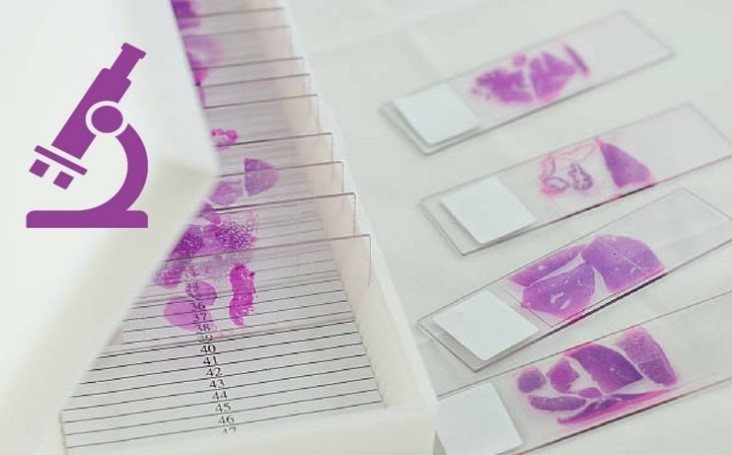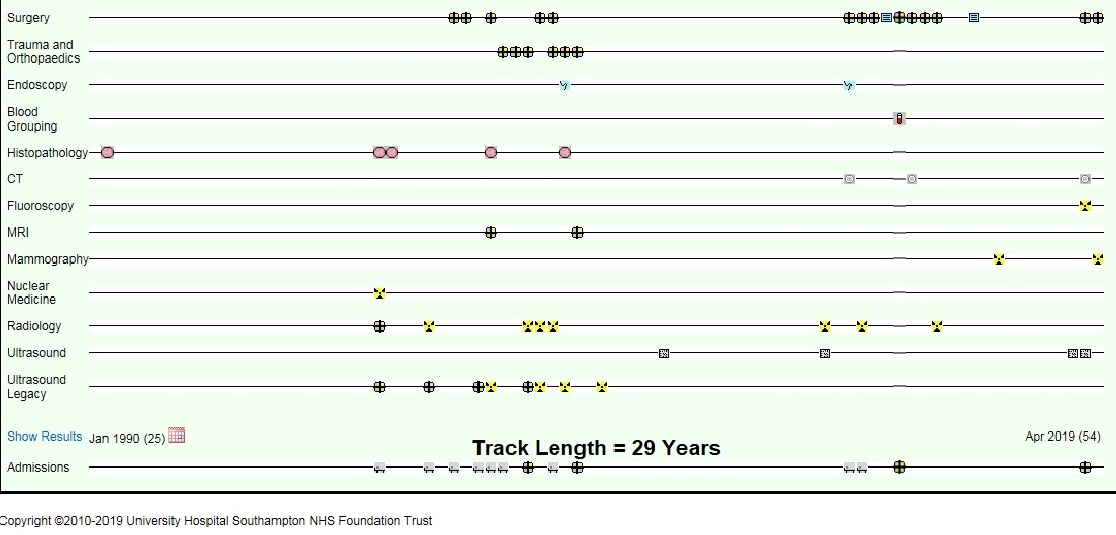Bringing cellular pathology reports back to life

Introduction
Cellular Pathology reports are very informative documents, with long term value as event and treatment markers in the Electronic Patient Record (EPR). As such, they are a key element in the UHS Lifelines EPR interface, with their own timeline.
A single cellular pathology report can have great retrospective clinical value, in confirming:
– The fact and findings of a biopsy or operative specimen
– The date and nature of the procedure that generated the specimen
UHS Lifelines displays all e-pathology reports from e-Quest laboratory results reporting system on the Cellular Pathology timeline as interactive 12×12 pixel icons at the relevant time point (Figure 1). The reports are all presented unchanged from the original electronically recorded text or image.

clinical record dating back to 1990
Figure 1. A UHS Lifelines screenshot of a clinical record with histopathology records dating back to 1990.
The backloading of archival Cellular Pathology records into UHS Lifelines
The early iterations of UHS Lifelines drew pathology reports from e-Quest from 2003 onwards. However, we were keen to enrich UHS Lifelines to the greatest possible degree with e-Pathology records from further back in time.
Prior to 1990, records were held on a card index and a microfilm system. It would have been possible to digitise these images and to add metadata manually to give them new life within the UHS Clinical Data Estate. However, this would have been a resource intensive exercise which we could not justify.
We therefore focussed on archival electronic reports. UHS pathology reports were originally written and stored in a Ferranti Computer System from January 1990 to mid-1997. These were transferred to the Clinisys (previously Masterlab) Labcentre system when the UHS Laboratory Information System (LIMS) went live in 1997.
We ran queries on our systems which demonstrated that Histopathology (HI) and Neuropathology (NE) reports were available in Labcentre from June 1997 to April 2003. A further search from May 1997 back to April 1990 on Labcentre discovered records which had been imported from the Ferranti system.
Archival Data Validation and Uploading
We had to validate the upcycled data to link the patient identifiers between our UHS Patient Master Index (PMI) and the individual reports. To be valid, the hospital number, NHS number and demographic data of any subject patient had to match the ex-Ferranti export data.
During 2013 and 2014, 373,342 validated histopathology reports were uploaded from the Ferranti and Masterlab/Labcentre system into the Trust’s e-Quest EPR results reporting system, for display in UHS Lifelines.
We then repeated the exercise for all traceable e-cytopathology reports, excluding cervical cytology reports which the hospital no longer processed.
Each archival e-report was tagged with sufficient metadata, in the form of a date/time stamp and its identity, to permit the UHS Lifelines upload.
The pathology laboratory now has an efficient and user friendly Business Objects tool (Sage Software) for record extraction from the UHS data warehouse from June 2013 onwards.
The Benefits for UHS Users
– All current and most cellular pathology reports back to 1990 are now immediately displayed in UHS Lifelines.
– New reports are immediately added to the live database and are accessible as soon as they are signed off and uploaded into e-Quest.
– The immediacy of access to restored archival cellular pathology records has practical value in the clinical services, and for longitudinal clinical research, including chronic diseases and childhood and adulthood, and in the study of cancer outcomes.
Future Developments with UHS Lifelines
UHS Lifelines is under continuous development by the UHS digital team. A significant upgrade (Lifelines-21) will be launched during 2021, with a range of new features. We welcome all feedback as to how the functionality of the system can be further improved.
Acknowledgements are due in particular to Alan Hales, David Cable, Matt Warren, Alex Mills-Mullett and Ryan Beegan for coding and implementation of the UHS Lifelines concept across the UHS Clinical Data Estate.
Particular gratitude for this element of the project goes to Keith Burrill and Adrian Bateman of the Department of Cellular Pathology
David Rew
Consultant General Surgeon
UHS Lifelines Concept Lead
University Hospital Southampton
March 2021
References
Rew DA, Hales AA, Cable D, Burrill K and Bateman AC.
New life for old cellular pathology: a transformational approach to the upcycling of historic e-pathology records for contemporary clinical uses
Journal of Clinical Pathology Published Online First: 16 February 2021. doi: 10.1136/jclinpath-2021-207385
